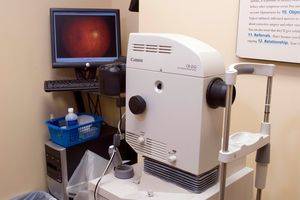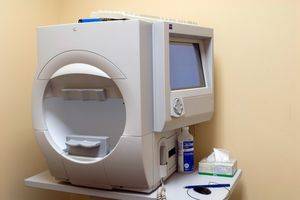Corneal Mapping
 Corneal topography, also known as photokeratoscopy or videokeratography, is a non-invasive medical imaging technique we use at our office in Mobile for mapping the surface curvature of the cornea, the outer structure of the eye. Since the cornea is normally responsible for some 70% of the eye’s refractive power, its topography is of critical importance in determining the quality of vision.
Corneal topography, also known as photokeratoscopy or videokeratography, is a non-invasive medical imaging technique we use at our office in Mobile for mapping the surface curvature of the cornea, the outer structure of the eye. Since the cornea is normally responsible for some 70% of the eye’s refractive power, its topography is of critical importance in determining the quality of vision.
The three-dimensional map is, therefore, a valuable aid to Dr. Jackson and can assist in the diagnosis and treatment of a number of conditions; in planning refractive surgery such as LASIK and evaluation of its results; or in assessing the fit of contact lenses. A development of keratoscopy, corneal topography extends the measurement range from the four points a few millimeters apart that is offered by keratometry to a grid of thousands of points covering the entire cornea. The procedure is carried out in seconds and is completely painless.
Special thanks to the EyeGlass Guide, for informational material that aided in the creation of this website.
Digital Retinal Imaging & OCT Scans
We at our office in Mobile, AL use cutting-edge digital imaging technology to assess the eyes of our neighbors in Mobile. Many eye diseases, if detected at an early stage, can be treated successfully without total loss of vision. Your retinal Images will be stored electronically. This gives the eye doctor a permanent record of the condition and state of your retina.
This is very important in assisting Dr. Jackson to detect and measure any changes to your retina as many eye conditions, such as glaucoma, diabetic retinopathy and macular degeneration are diagnosed by detecting changes over time.
The advantages of digital imaging include:
- Quick, safe, non-invasive and painless
- Provides detailed images of your retina and sub-surface of your eyes
- Provides instant, direct imaging of the form and structure of eye tissue
- Image resolution is extremely high quality
- Uses eye-safe near-infra-red light
- No patient prep required
Digital Retinal Imaging
Digital Retinal Imaging allows your eye doctor to evaluate the health of the back of your eye, the retina. It is critical to confirm the health of the retina, optic nerve and other retinal structures. The digital camera snaps a high-resolution digital picture of your retina. This picture clearly shows the health of your eyes and is used as a baseline to track any changes in your eyes in future eye examinations.
Optical Coherence Tomography (OCT)
 An Optical Coherence Tomography scan (commonly referred to as an OCT scan) is the latest advancement in imaging technology that is offered in our office in Mobile, AL. Similar to ultrasound, this diagnostic technique employs light rather than sound waves to achieve higher resolution pictures of the structural layers of the back of the eye.
An Optical Coherence Tomography scan (commonly referred to as an OCT scan) is the latest advancement in imaging technology that is offered in our office in Mobile, AL. Similar to ultrasound, this diagnostic technique employs light rather than sound waves to achieve higher resolution pictures of the structural layers of the back of the eye.
A scanning laser used to analyze the layers of the retina and optic nerve for any signs of eye disease, similar to a CT scan of the eye. It works using light without radiation, and is essential for early diagnosis of glaucoma, macular degeneration and diabetic retinal disease.
With an OCT scan, our Mobile doctors are provided with color-coded, cross-sectional images of the retina. These detailed images are revolutionizing early detection and treatment of eye conditions such as wet and dry age-related macular degeneration, glaucoma, retinal detachment and diabetic retinopathy.
An OCT scan is a noninvasive, painless test. It is performed in about 10 minutes right in our office. Feel free to contact our office to inquire about an OCT at your next appointment.
Fundus Photography

Photographs of the inside of the eye allow Dr. Jackson to monitor for changes in structure over time and help in making sure treatment regimens for eye disease are effective. The Fundus Camera which is basically a high powered microscope with a flash camera attached. Take highly detailed images of the anterior of the eye (such as the retina), this is primarily in order to check for small changes that are only in eyes that have certain diseases. For example the Fundus camera is very successful at detecting diabetic retinopathy, and it is recommended that anyone with diabetes should go to their optometrist for a Fundus camera imaging every 6 months to a year.
Visual Field Testing
A visual field test measures how much ‘side’ vision you have. It is a straightforward test, painless, and does not involve eye drops. Essentially lights are flashed on, and you have to press a button whenever you see the light. Your head is kept still and you have to place your chin on a chin rest. The lights are bright or dim at different stages of the test. Some of the flashes are purely to check you are concentrating.
Each eye is tested separately and the entire test takes 15-45 minutes. Your optometrist may ask only for a driving licence visual field test, which takes 5-10 minutes. If you have just asked for a driving test or the clinic doctor advised you have one, you will be informed of the result by the clinic doctor, in writing, in a few weeks.
Normally the test is carried out by a computerized machine, called a Humphrey. Occasionally the manual test has to be used, a Goldman. For each test you have to look at a central point then press a buzzer each time you see the light.
Specular Microscopy
 Your cornea, the front window of the eye, has 5 layers. The inner layer is called the corneal endothelium. This layer maintains the hydration of the other inner layers by acting as a pumping mechanism. This pumping mechanism can fail leading to a cloudy cornea and a condition called Fuch’s endothelial dystrophy. The endothelial layer can be replaced surgically. We at our office in Mobile, AL monitor the health of the endothelium using specualr microscopy to determine when and if surgery is necessary. The quality of vision is greatly affected by the clarity of the cornea.
Your cornea, the front window of the eye, has 5 layers. The inner layer is called the corneal endothelium. This layer maintains the hydration of the other inner layers by acting as a pumping mechanism. This pumping mechanism can fail leading to a cloudy cornea and a condition called Fuch’s endothelial dystrophy. The endothelial layer can be replaced surgically. We at our office in Mobile, AL monitor the health of the endothelium using specualr microscopy to determine when and if surgery is necessary. The quality of vision is greatly affected by the clarity of the cornea.
Book and exam for the treatment of Dry Eye or call us to find out more information.


